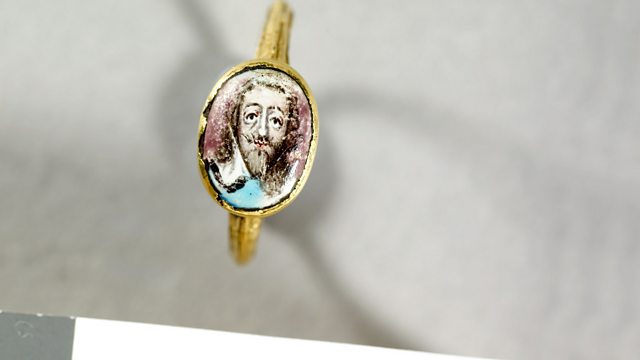The People
Will Gompertz explores the unspoken and unwritten contract that has existed between the rulers and the ruled. From March 2012.
The Royal Collection is one of the most wide-ranging collections of art and artefacts in the world and provides an intriguing insight into the minds of the monarchs who assembled it.
During the series, Will Gompertz encounters dozens of these unique objects - some priceless, others no more than souvenirs - each shedding light on our relationship with the monarchy and giving a glimpse into the essential ingredients of a successful sovereign.
In this programme, Will investigates the unspoken and unwritten contract that has existed between the rulers and the ruled in this country. Over the centuries, both parties have used compromise and conflict, threat and reward. Will uses six objects from the Collection to illuminate some of the pivotal moments in this relationship.
From the Wriotheseley Garter Book, dating from the 1520s, one of the earliest depictions of Parliament in action, to a ring keeping the memory of the recently executed King Charles I alive, Will sees both extremes of the relationship between monarch and subject. He encounters the face of revolution in an early photograph purchased by Prince Albert and meets some of those recently touched by a sword that belonged to King George VI, now known as the Investiture Sword, as he gets to the heart of the might and the majesty of monarchy.
Producer: Neil George.
Last on
![]()
Listen to a selection of programmes and clips related to The Art of Monarchy: People
Memorial ring bearing a miniature of Charles I

Memorial ring bearing a miniature of Charles I (1600-49). Memorial rings bearing the portrait of Charles I were worn by Royalist supporters during the Civil War (1642 - 1651) and following the King's execution in 1649.
��
From: England. First recorded in the Royal Collection during the reign of King George V (1865-1936)
Date: c. 1650 - 1700
Material: Gold and enamel
Size: 16 x 8 mm
��
��
��
Caddinet with the arms of William and Mary

Caddinet made by Anthony Nelme (fl. 1680-1720). A caddinet is used at formal banquests for the service of salt and spices. This example was made for the coronation of William III and Mary II. At the time it was made, Scotland had not formally acknowledged William III and Mary II as Sovereigns and consequently the Scottish coat of arms is absent and that of Ireland is used twice.
��
From: England. Made for the Coronation of William III (1650-1704) and Mary II (1662-1694)
Date: 1688
Material: Silver gilt
Size: 394 x 311 mm
��
��
��
��
��
The Wriothesley Garter Book

The Wriothesley Garter Book, by Sir Thomas Wriothesley (c. 1460-1534). This book contains possibly the first contemporary view of Parliament at Blackfriars, depicting Henry VIII enthroned.
��
From: England. Acquired during the reign of Queen Victoria (1819-1901)
Date: c.1530
Material: Manuscript on vellum, with body colour and gold leaf, brush and pen linear work
Size: 308 x 222 mm
��
��
Daguerreotype recording the Chartist Meeting on Kennington Common

Daguerreotype recording the Chartist Meeting on Kennington Common, by William Edward Kilburn (1818-1891). Prince Albert was deeply concerned for the welfare of the working classes and frequently wrote to the Government on the subject of unemployment.
��
From: England. Acquired by Prince Albert
Date: 4/10/1848
Material: Daguerreotype
Size: 107 x 147 mm
��
��
��
The Garden Party at Buckingham Palace 28 June 1897

The Garden Party at Buckingham Palace 28 June 1897, by Laurits Regner Tuxen (1853-1927). Queen Victoria began the tradition of garden parties at Buckingham Palace in the 1860s. This painting was commisioned in the year of her Diamond Jubilee.
��
From: England. Commissioned by Queen Victoria (1819-1901)
Date: 1897-1900
Material: Oil on canvas
Size: 1677 x 2287 mm
��
��
��
��
Investiture sword and scabbard

Sword and scabbard, made by Edward Smith. This sword, which belonged to George VI, is used by Her Majesty The Queen at Investitures. Around 25 Investitures are held each year. The majority take place at Buckingham Palace, the Palace of Holyrood House in Edinburgh and Windsor Castle.
��
From: England. This belonged to King George VI (1895-1952)
Date: c.1910-1932
Material: Nickel plate, iron, steel, wood, fish skin, silver, and gold braid
Size: 825 mm (blade)
��
More from Radio 4: The Great Reform Act

Melvyn Bragg and guests discuss the Great Reform Act of 1832. The Act redrew the map of British politics in the wake of the Industrial Revolution and is a landmark in British political history. But to what extent was Britain’s political system transformed by the Great Reform Act? What were the causes of reform in the first place and was the Act designed to encourage democracy in Britain or to head it off?
��
More from Radio 4: The Social Contract

Melvyn Bragg and guests discuss the Social Contract and ask a foundational question of political philosophy – by what authority does a government govern?
��
More from Radio 4: Civil War

Helen Castor talks to Professor Mark Stoyle of the University of Southampton about the moment that the reality of the civil war hit home for the English in 1642 and people had to chose between King or Parliament. Forced out of London, King Charles 1st uses Commissions of Array to recruit supporters but as Mark Stoyle explains there were many places where these simply did not work.
��
Broadcasts
- Sat 10 Mar 2012 10:30���˿��� Radio 4
- Sat 26 Aug 2017 07:30���˿��� Radio 4 Extra
- Sat 26 Aug 2017 17:30���˿��� Radio 4 Extra
- Sun 27 Aug 2017 05:30���˿��� Radio 4 Extra
Podcast
-
![]()
The Art of Monarchy
Will Gompertz examines objects in the Royal Collection that define the British monarchy.




